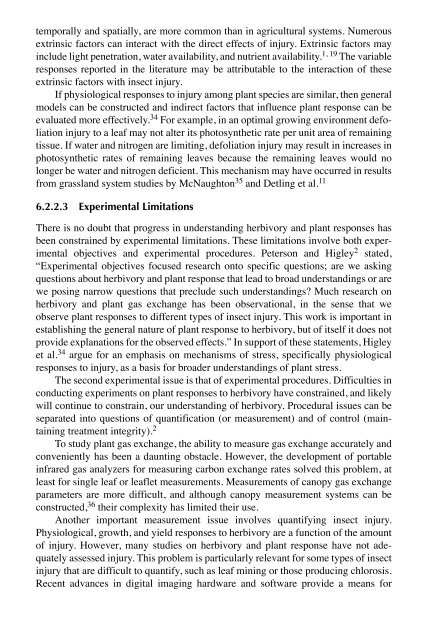Biotic Stress and Yield Loss
Biotic Stress and Yield Loss
Biotic Stress and Yield Loss
- No tags were found...
You also want an ePaper? Increase the reach of your titles
YUMPU automatically turns print PDFs into web optimized ePapers that Google loves.
temporally <strong>and</strong> spatially, are more common than in agricultural systems. Numerousextrinsic factors can interact with the direct effects of injury. Extrinsic factors mayinclude light penetration, water availability, <strong>and</strong> nutrient availability. 1, 19 The variableresponses reported in the literature may be attributable to the interaction of theseextrinsic factors with insect injury.If physiological responses to injury among plant species are similar, then generalmodels can be constructed <strong>and</strong> indirect factors that influence plant response can beevaluated more effectively. 34 For example, in an optimal growing environment defoliationinjury to a leaf may not alter its photosynthetic rate per unit area of remainingtissue. If water <strong>and</strong> nitrogen are limiting, defoliation injury may result in increases inphotosynthetic rates of remaining leaves because the remaining leaves would nolonger be water <strong>and</strong> nitrogen deficient. This mechanism may have occurred in resultsfrom grassl<strong>and</strong> system studies by McNaughton 35 <strong>and</strong> Detling et al. 116.2.2.3 Experimental LimitationsThere is no doubt that progress in underst<strong>and</strong>ing herbivory <strong>and</strong> plant responses hasbeen constrained by experimental limitations. These limitations involve both experimentalobjectives <strong>and</strong> experimental procedures. Peterson <strong>and</strong> Higley 2 stated,“Experimental objectives focused research onto specific questions; are we askingquestions about herbivory <strong>and</strong> plant response that lead to broad underst<strong>and</strong>ings or arewe posing narrow questions that preclude such underst<strong>and</strong>ings? Much research onherbivory <strong>and</strong> plant gas exchange has been observational, in the sense that weobserve plant responses to different types of insect injury. This work is important inestablishing the general nature of plant response to herbivory, but of itself it does notprovide explanations for the observed effects.” In support of these statements, Higleyet al. 34 argue for an emphasis on mechanisms of stress, specifically physiologicalresponses to injury, as a basis for broader underst<strong>and</strong>ings of plant stress.The second experimental issue is that of experimental procedures. Difficulties inconducting experiments on plant responses to herbivory have constrained, <strong>and</strong> likelywill continue to constrain, our underst<strong>and</strong>ing of herbivory. Procedural issues can beseparated into questions of quantification (or measurement) <strong>and</strong> of control (maintainingtreatment integrity). 2To study plant gas exchange, the ability to measure gas exchange accurately <strong>and</strong>conveniently has been a daunting obstacle. However, the development of portableinfrared gas analyzers for measuring carbon exchange rates solved this problem, atleast for single leaf or leaflet measurements. Measurements of canopy gas exchangeparameters are more difficult, <strong>and</strong> although canopy measurement systems can beconstructed, 36 their complexity has limited their use.Another important measurement issue involves quantifying insect injury.Physiological, growth, <strong>and</strong> yield responses to herbivory are a function of the amountof injury. However, many studies on herbivory <strong>and</strong> plant response have not adequatelyassessed injury. This problem is particularly relevant for some types of insectinjury that are difficult to quantify, such as leaf mining or those producing chlorosis.Recent advances in digital imaging hardware <strong>and</strong> software provide a means for

















